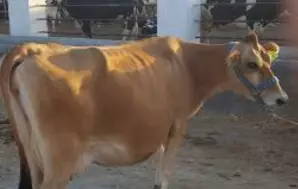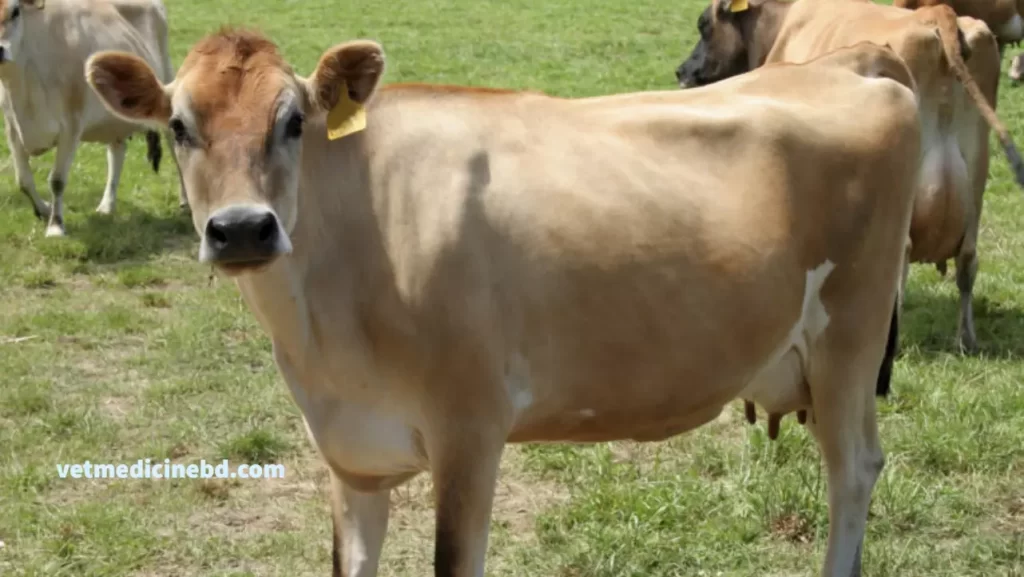Jersey cows do not breathe in excess heat like other cows, their temperature tolerance is much higher. They have hair on their heads. So clean it regularly with shampoo and keep it tidy with a comb. The ears of Jersey cows are small and always alert. They will turn their ears like radar and aim at you, always ready to hear what you have to say.
They are much smarter and calmer than other cows. Sometimes being angry will put you in danger. They always want to caress, if you call, they will come to you in no time, no matter how far away they are. There is nothing to say about their food. If there is food, they are very busy with it, they will not lift their heads easily anymore.
Table of Contents
How do you recognize a Jersey cow?
Jersey is the only cow in the world that has its own territory, meaning its own country and dignity. There are also football and cricket teams with their own name. Jersey Island between France and England. How did the name Jersey come about? From the British Isles of Jersey in the English Channel.
Jersey is one of the most well-known breeds of cattle in the world. They are quite small, but they are world famous for milk. This variety is now found in almost all countries of the world. Many of us don’t know how to recognize Jersey cows. Today’s article is to give that solution.
Color
This type of cow range in color from light white/gray to almost black. Garo may be brown/gray to red in color but has a white tinge to the body. Maybe a diamond-shaped patch on the shoulder or buttocks or white legs or maybe a white stripe from the top of the shoulder to the back of the elbow.

But a real jersey cow’s nose and hooves must be black. There is often a light color around their eyes and nose. The color of the inner part of each foot is quite light. Lots of light brown cows with dark-colored faces can be seen.
Bulls are often dark in color from head to toe. Because of their dark eyes and dark noses, they look more adorable than all the other breeds.
Body type and characteristics
The Jersey beef bone structure and flesh shape are better than any other beef breed. Due to their angular shape in body type, Jersey breeds are reared as dairy breeds rather than beef breeds.
They have funnel-shaped buttocks similar to Holstein’s, as well as being quite thin and boneless. Jerseys are much smaller than Holstein’s, adult Jersey cows weigh between 400 kg and 500 kg (80 to 1100 lb). Adult bulls weigh 540 to 720 kg (1190 to 1810 lb).
After birth, the calf weighs about 25 to 26 kg. Due to the large size of their udder, they give much more milk than the calf needs. A Jersey cow produces 6,000–7,000 kg of milk in a lactation period, which is about 13 times its body weight.
The structure of the head
The Jersey cow is characterized by a smooth feminine appearance, mainly due to the shape of its head. Their heads are finer than those of the Harrowford or Angus cows, much like the shorthorn cows. Jersey is a naturally horned variety, the horns are thin and slightly curved towards the front
Jersey cow milk
Their milk is made by the A2 casing bond of protein, easily digestible. Even if left out, it will not be as easily nourished as other kinds of milk. The fat percentage in the milk of this cow is more than the number of cows in the world. So Jersey cow’s milk is the number one choice for making ghee, cheese, butter, lamb, cheese, and yogurt all over the world.
Illness ailments and others
Jersey cows can adapt very well to extreme temperatures. Their coats can be thick during the winter. They are economically viable as they can easily adapt to any weather.
Jersey cows are quite calm and fortunate animals, but there is a possibility of a light kick when it comes to milk. The milk you get when you kick is the best quality which is great to use for dairy products like cheese, butter, and ice cream.
Lifetime
Due to low weight, low cost, and tendency to eat grass, more cows can be reared in less space. This breed of cows is high in fertility so there are no problems with pregnancy and no problems with childbirth.
While most cattle live between the ages of 18 and 22, it is not uncommon for Jersey to live 25 or more years. The world’s oldest Jersey cow was alive at the age of 37 at an animal rescue center in the United Kingdom.
Immunity of Jersey cow
The immunity of Jersey cattle is great. Mastitis and dystocia are very rare in Jersey cattle. Some studies have shown that Jersey cows are half as likely to suffer from wool-related problems as Holstein Friesians.
As the hooves are hard and black hooves, it can be said that this breed of cow does not get FMD or hoof disease. Such cows are therefore a blessing for the farm.
Milk fever
It is important to keep in mind that Jersey cows are slightly more likely to develop ‘milk fever’ than others. Weakness, restlessness and tendency to lie down excessively after delivery – these symptoms should be noted with caution.
If necessary, the advice of the nearest veterinary doctor should be taken. With the exception of milk fever, the birth process is usually hassle-free.
Fertility
Calves are small at birth which simplifies this process. One study found that 96% of first-time veterinarians in Jersey did not need any help from veterinarians, which is close to 99% of second-time deliveries.
Their fertility rate is quite good, many cows give birth for the first time after reaching 19 months. The gap between the two deliveries is also small.
High quality milk from grass at low cost is the magic of Jersey Cows. So all in all, why are you late, we can come to your dairy farm next month, an excellent Jersey cow!
You can also read- Gir cow of Gujarat in India.

